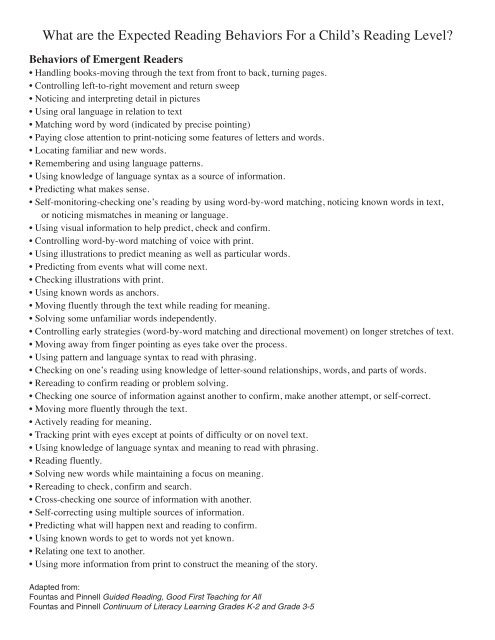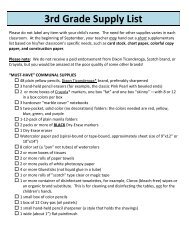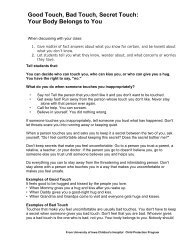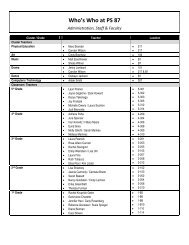Reading Behaviors Chart - Ps 87
Reading Behaviors Chart - Ps 87
Reading Behaviors Chart - Ps 87
You also want an ePaper? Increase the reach of your titles
YUMPU automatically turns print PDFs into web optimized ePapers that Google loves.
What are the Expected <strong>Reading</strong> <strong>Behaviors</strong> For a Child’s <strong>Reading</strong> Level<br />
<strong>Behaviors</strong> of Emergent Readers<br />
• Handling books-moving through the text from front to back, turning pages.<br />
• Controlling left-to-right movement and return sweep<br />
• Noticing and interpreting detail in pictures<br />
• Using oral language in relation to text<br />
• Matching word by word (indicated by precise pointing)<br />
• Paying close attention to print-noticing some features of letters and words.<br />
• Locating familiar and new words.<br />
• Remembering and using language patterns.<br />
• Using knowledge of language syntax as a source of information.<br />
• Predicting what makes sense.<br />
• Self-monitoring-checking one’s reading by using word-by-word matching, noticing known words in text,<br />
or noticing mismatches in meaning or language.<br />
• Using visual information to help predict, check and confirm.<br />
• Controlling word-by-word matching of voice with print.<br />
• Using illustrations to predict meaning as well as particular words.<br />
• Predicting from events what will come next.<br />
• Checking illustrations with print.<br />
• Using known words as anchors.<br />
• Moving fluently through the text while reading for meaning.<br />
• Solving some unfamiliar words independently.<br />
• Controlling early strategies (word-by-word matching and directional movement) on longer stretches of text.<br />
• Moving away from finger pointing as eyes take over the process.<br />
• Using pattern and language syntax to read with phrasing.<br />
• Checking on one’s reading using knowledge of letter-sound relationships, words, and parts of words.<br />
• Rereading to confirm reading or problem solving.<br />
• Checking one source of information against another to confirm, make another attempt, or self-correct.<br />
• Moving more fluently through the text.<br />
• Actively reading for meaning.<br />
• Tracking print with eyes except at points of difficulty or on novel text.<br />
• Using knowledge of language syntax and meaning to read with phrasing.<br />
• <strong>Reading</strong> fluently.<br />
• Solving new words while maintaining a focus on meaning.<br />
• Rereading to check, confirm and search.<br />
• Cross-checking one source of information with another.<br />
• Self-correcting using multiple sources of information.<br />
• Predicting what will happen next and reading to confirm.<br />
• Using known words to get to words not yet known.<br />
• Relating one text to another.<br />
• Using more information from print to construct the meaning of the story.<br />
Adapted from:<br />
Fountas and Pinnell Guided <strong>Reading</strong>, Good First Teaching for All<br />
Fountas and Pinnell Continuum of Literacy Learning Grades K-2 and Grade 3-5
<strong>Behaviors</strong> of Early Readers<br />
• Being aware of punctuation and using it for phrasing and meaning.<br />
• Searching visual information to figure out new words while reading.<br />
• Using the syntax of written language to predict, and then checking the accuracy of the prediction.<br />
• Analyzing new words and checking them against what makes sense or sounds right.<br />
• Controlling early strategies even on novel texts.<br />
• <strong>Reading</strong> with fluent phrasing and attention to meaning.<br />
• Moving quickly through text.<br />
• Using known words and parts of words as well as letter-sound relationships to get to new words,<br />
and checking against other information such as meaning.<br />
• Using multiple sources of information to self-correct.<br />
• Moving through text using pictures and print in an integrated way while attending to meaning.<br />
• Solving new words by using word analysis, then checking the words against meaning.<br />
• Monitoring one’s reading (accurately reading long stretches of text with intermittent hesitations and repeats.)<br />
• Self-correcting close to the point of error.<br />
• Rereading to check and search.<br />
• Discussing ideas from the story in a way that indicates understanding and discussing characters in a way<br />
that indicates understanding and interpretation.<br />
• Effectively managing a variety of texts, including fiction and informational texts.<br />
• Connecting text to other texts.<br />
• Fluent and phrased reading, especially when rereading.<br />
• Competent problem solving of new words on initial reading.<br />
• Flexibly checking one’s reading against meaning.<br />
• Using information sources (meaning, syntax, and visual information) in integrated ways while<br />
focusing on meaning.<br />
• Making connections between texts through discussion, art, or writing.<br />
• Demonstrating an understanding of and empathy with characters through discussion, art, or writing.<br />
• Moving toward easy, fluent reading even of unfamiliar and difficult texts, demonstrating less overt<br />
problem solving.<br />
• Self-correcting at the point of error with fewer returns to the beginning of sentences or phrases.<br />
• Coping with unfamiliar concepts.<br />
• Gaining momentum while moving through the text because knowledge is being constructed about<br />
how this text works and what it likely to say.<br />
• Using skills and strategies effectively on a variety of texts.<br />
• Sustaining interest and fluency through a longer text.<br />
• Easily coming back to a text if it requires more than one sitting.<br />
• Solving unfamiliar words or concepts “on the run” without detracting from meaning.<br />
• Self-correcting when necessary to support meaning but showing a general forward thrust<br />
(checking and self-correcting behaviors become less overt and more internal).<br />
• <strong>Reading</strong> silently much of the time, no longer finding it necessary to vocalize every word.<br />
• Demonstrating an understanding of the story or text through discussion, art, and writing.<br />
• Moving flexibly from nonfiction to fiction and vice versa.<br />
• Using ideas from one’s reading in one’s writing.<br />
• Summarizing or extending a given text.
<strong>Behaviors</strong> of Early Fluent Readers<br />
• Using multiple sources of information in an integrated way.<br />
• Effectively and efficiently analyzing longer words.<br />
• Using a variety of word analysis strategies without losing meaning or fluency.<br />
• <strong>Reading</strong> in a phrased, fluent way over longer stretches of text<br />
• Demonstrating through discussion, writing, or other media that they can understand and interpret<br />
the stories from different perspectives and empathize with the characters.<br />
• Using text structure (both narrative and logic) to predict a likely sequence of events or to analyze<br />
and critique the text.<br />
• Sustaining characters and plot over several days.<br />
• Longer stretches of text<br />
• More difficult vocabulary, ideas and language structures.<br />
• More complex ideas and topics<br />
• A greater range of genre<br />
• Use texts as references<br />
• Search for and find information in texts<br />
• Interpret texts from a variety of perspectives<br />
• Read critically<br />
• Understand subtleties of plot and humor<br />
• Reflect on their personal response in relation to how others see the text.<br />
• Processing short fiction stories, chapter books, short informational texts, series books or mysteries<br />
• <strong>Reading</strong> fiction texts that have many characters that change in the story<br />
• <strong>Reading</strong> nonfiction texts on many related topics<br />
• Automatically using strategies (using word parts like prefixes/suffixes)<br />
• <strong>Reading</strong> and understanding descriptive words<br />
• Slowing down to understand or search for information<br />
• <strong>Reading</strong> and understanding books with sequels or short stories<br />
• Understanding difficult sentences and words<br />
• Figuring out new vocabulary by using context clues<br />
• <strong>Reading</strong> nonfiction texts that give information on new topics<br />
• Understanding mature themes (race, culture)<br />
• Making sense of new vocabulary words<br />
• Comfortably reading silently at a good rate
<strong>Behaviors</strong> of Fluent Readers<br />
• <strong>Reading</strong> and understanding characteristics of most genres<br />
• <strong>Reading</strong> and understanding biographies<br />
• Understanding texts with different layouts<br />
• Looking for information in pictures, photographs, maps, charts<br />
• <strong>Reading</strong> diaries and logs<br />
• Automatically breaking words into syllables to figure out difficult words<br />
• <strong>Reading</strong> longer texts with many lines of print that require remembering lots of information<br />
• Searching for and using information found in a text<br />
• Using prior knowledge to understand a text<br />
• <strong>Reading</strong> and understanding myths and legends<br />
• <strong>Reading</strong> and understanding books with mature themes (poverty, war, abuse)<br />
• Using tools such as glossaries<br />
• <strong>Reading</strong> texts with long sentences and paragraphs<br />
• <strong>Reading</strong> texts that require knowing about history and science<br />
• Using critical thinking skills







